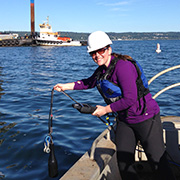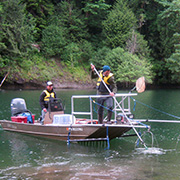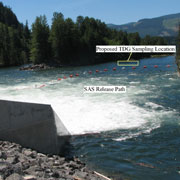Water Quality / Quantity Assessments
Mukilteo Tank Farm Pier Demolition and Dredging Water Quality Monitoring
Pacific Pile & Marine 
Washington State Ferries and the Federal
Transit Administration are relocating the
ferry terminal in Mukilteo to improve safety
and reliability of operations for vehicle and
passenger traffic, and reduce congestion along
Mukilteo's waterfront. Pacific Pile and Marine
is demolishing an existing pier and dredging
the shoreline at the new terminal location.
Meridian was retained to train employees in
water quality monitoring methods to ensure
compliance with turbidity, pH, and chemical
standards throughout the construction period.
Removal of the existing pier will eliminate
thousands of tons of toxic, creosote-treated
pilings from Puget Sound.
Yale Tailrace Water Quality Attainment Study
PacifiCorp 
Meridian conducted a detailed assessment of
the fish assemblage and water temperature
regime in the Lake Merwin Canyon, which is
influenced by discharge from the Yale Project
powerhouse. Meridian quantified seasonal and
diel fish assemblage and distribution by depth
using tangle-netting and boat electrofishing.
We measured water temperature patterns by
anchoring four vertical thermistor strings in
strategic locations and analyzed the detailed
fish presence and water temperature data and
related this to discharge from the Yale
Hydroelectric Project. Fish presence was
related to water temperature by depth and
reach. Water temperature data was related to
project generation and identified correlation
between maximum water temperature, temperature
fluctuation and project generation/discharge.
Meridian made recommendations on operation
changes to increase cold water habitat
availability for cold water aquatic biota.
Swift No. 2 Hydroelectric Project Water Temperature and TDG Monitoring
Cowlitz County PUD 
Meridian consulted with the Department of
Ecology, prepared a Water Quality Monitoring
Plan, and conducted water temperature and TDG
monitoring studies in the project power canal,
surge arresting structure, and tailrace over a
10-year period. Hourly data was compiled,
analyzed, and graphed to evaluate compliance
with state water quality standards and the
monitoring results were documented in a series
of annual technical reports.
Twin Falls Hydroelectric Project Water Temperature and Dissolved Oxygen Monitoring
Enel North America
Meridian monitored water temperature and
dissolved oxygen for two years in reaches of
the South Fork Snoqualmie River using two
Hydrolab MiniSondes. Data were downloaded
monthly to evaluate whether any exceedences of
state water quality standards were a function
of project operations or natural conditions.
Hourly data were graphed and analyzed to
determine monthly and daily maximums, means,
and minimums, and temperature data were
expressed as seven-day averages (7-DADMax). We
also consulted with resource agencies and
tribes, prepared annual technical reports and
a successful Section 401 permit application to
modify the project's required minimum instream
flow releases.

